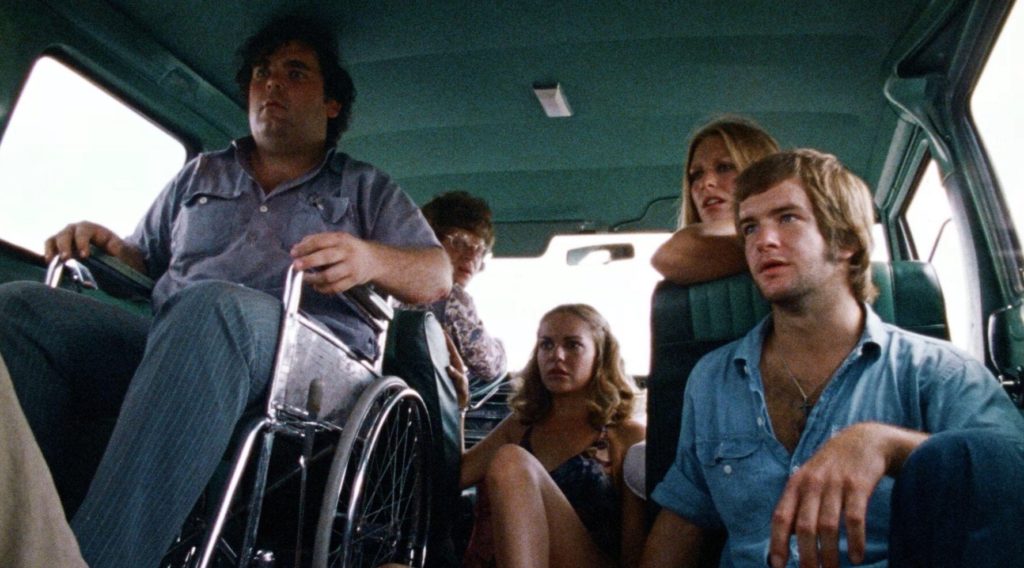The Texas Chainsaw Massacre
1974

Rated: R
Genre: Horror
Country: U.S.
Run-Time: 1h 23min
Director: Tobe Hooper
Cast
Marilyn Burns………….Sally Hardesty
Paul A. Partain………..Franklin Hardesty
Edwin Neal……………….Hitchhiker
Gunnar Hansen………Leatherface
The Texas Chainsaw- sometimes spelled Chain Saw– Massacre has a reputation that conjures up real terror in those who have not seen it. What gory hell could possibly be in THAT movie? Adding to its notorious reputation were a whole host of countries that banned the film upon release: including France, Germany and Sweden.
And yet the director, Toby Hooper, actually was aiming for a PG rating by leaving most of the killing off screen. (I don’t know how he thought hanging a woman on a meat hook was going to pass muster.) So what gives?
The truth is The Texas Chainsaw Massacre has boatloads of gore, but very little comes in the form of the deaths of our young protagonists. Hooper’s film is surprisingly a master class in implied horror and tension building. Instead, the gore is spread about the set pieces which are littered with ingenious props such as bone couches, corpse sculptures and an armchair with…arms. (Is there a body behind the chair?) Seems Leatherface has a creative side. Gore is also in the makeup and costume designs of the more grotesque members of the Slaughter- they were not yet the Sawyer- family. It is everywhere except in the places where those who have not seen the film expect to find it. In fact, the film is actually shockingly light on chainsaw massacring, but it is heavy on detailed sets and good filmmaking techniques.
The Texas Chainsaw Massacre starts with the oft fictitious claim that we are watching a true story, here narrated to near perfection by actor John Larroquette. The narration is a little too long and reveals a little too much (or does it?), but as foreboding foreshadowing it is remarkably effective, especially when juxtaposed by camera flashes of body parts we can only assume is from a police investigation.
We’ll soon flash back to the point where the story begins. Now tell me if you seen this before? A group of young people go on a road trip and end up somewhere they shouldn’t have. If you’ve seen this scenario play itself out in countless films, that is because The Texas Chainsaw Massacre pretty much invented and then simultaneously perfected the road-trip-turned-sour formula.
After the title credits, we learn that the Texas media is reporting that graves were desecrated and Sally Hardesty, her boyfriend Jerry, her paraplegic brother Franklin and friends Kirk and Pam take a trip to ensure grandfather Hardesty’s resting place has been left undisturbed.
During their excursion, the group picks up an unusual hitchhiker (Edwin Neal) whose manic behaviour eventually leads to a swift exit. And truthfully, for all the talk of Leatherface, I personally feel that Neal’s character steals the show, as he makes the absolute most out of all the screen time he is provided. It is pure uneasy joy watching the interaction between odd-duck Franklin and Neal’s character turn sour and one of those nice, but rarely discussed, touches that have helped cement the film’s legendary status.
Our next stop is the gas station. It is a scene chalked full of irony, playing out the traditional warning-of-danger road trip trope before later subverting it. Of course the pumps are empty, so the gang decides to spend the night at the abandoned Hardesty homestead and return to the gas station the next day, after it receives its fuel delivery.
Obviously, things will not go as planned.
Perhaps the most impressive thing about The Texas Chainsaw Massacre is how well it has aged. Unlike Wes Craven’s classic The Last House on the Left (which is more extreme than horror), you do not have to overlook uncomfortable, ill-conceived scenes with blatant racism and sexism to appreciate this one. Hooper’s film may look 1970’s, but there is a timeless quality to its construction. There is little wonder why so many of today’s directors have taken inspiration from The Texas Chainsaw Massacre story and aesthetic.
But it’s the madness in the film’s third act that has really cemented the film’s legacy. Trying to piece together the history of the Slaughter (or Sawyer) family based on the fragments we are given is all part of the fun. Just wait till you meet Grandpa. (There are some horrendous stories about the filming of the infamous dinner sequence and I hope actress Marilyn Burns has found herself well compensated.) Later attempts at franchising the film would sadly replace the mystique and macabre charm of the original with more gore and lore, but nothing has ever come close to matching our introduction to horror’s favourite family of cannibalistic maniacs.
Somewhere in The Texas Chainsaw Massacre‘s mythology, it became impossible to get a definitive number on the film‘s budget, but even the higher end figures are under $300 000. Eventually, it would earn over 30 million at the box office and become the 12th highest grossing film of 1974. And who can say how much its earned over the years V/H/S, DVD, Blu-ray and streaming sales…plus all that merchandise bearing Leatherface’s iconic image? Not a bad return on investment. I only bring this up as another reminder that horror never has been a genre that needs inflated budgets to be successful. This is as true today as it was fifty years ago. All it takes is the talent, will and a really good idea.